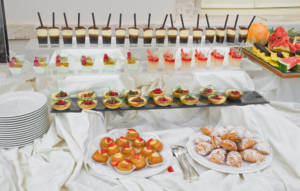
Food stations are a fun and flexible option for any type of wedding, and you should consider them when planning your wedding reception meal options.
As you try to figure out your reception meal options, you’re probably inundated with tons of possibilities. Maybe a typical sit-down dinner isn’t suitable for your casual wedding, or you’re not thrilled about the idea of long buffet lines. On the other hand, you may want to encourage guests to mingle more during the celebration. Maybe it’s time to consider food stations, an appropriate option for formal, semiformal, and casual affairs.
The Low-Down on Food Stations
Brides writer Heather Lee explains how food stations work in an April 2018 article. For your food station setup, you’ll break down your menu into individual categories and then assign each one to a freestanding table. Your guests can then choose from available options and either serve themselves or request made-to-order items.
How should you divide up your reception menu dishes into individual stations? Your caterer can offer some guidance, but some typical arrangements include the following:
- Assigned stations for entrées, salads, side dishes, breads, and desserts
- Foods grouped by their countries of origin
- Heavy appetizer stations
Of course, these are just a few possibilities. You can conceivably divvy up your offerings according to any scheme you wish, as long as you have the room and the budget.
Consider These Key Advantages
In her Brides article, Lee points out several advantages that food stations have over traditional plated multicourse or buffet meals. Your invitees can mingle and eat as they wish, allowing for more opportunities to interact with each other. Made-to-order items are prepped to their specifications, reducing the chance that they’ll be unhappy with their meals. You can also designate some stations to offer alternatives for guests with dietary restrictions. Finally, spreading the stations throughout your venue cuts down on long lines and waiting times.
Planning Tips for Your Food Stations
At the same time, you must also plan properly to ensure that your food station reception is successful. Southern Living, a United States-based lifestyle magazine, mentions that placing your stations too close together can lead to reduced floor traffic flow, longer lines, and congestion. For that reason, you’ll need a reception venue with plentiful room in order to properly space your stations. Be sure to budget appropriately, as Brides writer Heather Lee clarifies that you’ll need additional chefs for interactive stations and more staff to bus tables and assist with cleanup.
Not only that, guests with food allergies and dietary restrictions will require additional assistance in navigating your stations. Wedding Wire Canada’s Alice Prendergast stresses the importance of labeling stations to indicate whether they have vegetarian, vegan, gluten-free, or nut-free dishes. She also recommends allowing guests with food restrictions to serve themselves first. You’ll ensure that they won’t have to contend with cross-contamination from serving spoons accidentally placed in the wrong dishes.
Stumped for Ideas? Try These Recommendations
Want to incorporate food stations but you’re stumped for cuisine or theme ideas? No worries. You’ll find loads of suggestions at many wedding websites. The Knot mentions several unique food station setups to surprise and delight your guests, with standouts such as a late-night snack bar or mashed potato bar. For brunch receptions, Wedding Wire Canada offers great recommendations such as pancake and waffle, salad, and cereal stations. Lunch and dinner receptions may benefit from Wedding Wire Canada’s savory food station suggestions to please your guests’ palates.
Food stations are becoming more popular at weddings for several reasons. They allow people to select their food when they wish while giving them more opportunities to move around and socialize. For hosts, they provide the chance to offer fun food while accommodating invitees with food restrictions. With wise planning and smart menu selections, your food stations will be a big hit with your guests.


